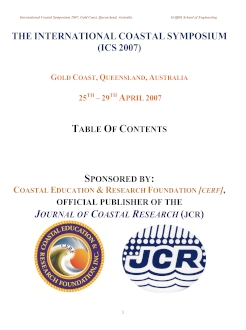Yamada, F., Uehara, K., Hokamure, T. and Yamabe, T., 2007. Morphology and seasonal evolution of intertidal multiple sand bars in low wave environment. Journal of Coastal Research, SI 50 (Proceedings of the 9th International Coastal Symposium), 978 – 984. Gold Coast, Australia, ISSN 0749.0208
The morphology of intertidal multiple sand bars of Okoshiki Beach in Ariake Bay, Japan is examined to provide insight into the factors controlling the bar characteristics in the low wave environment. Cross-shore profiles of intertidal multiple sand bars were measured monthly for 2 years from July, 2003 to July, 2005. Each measured profile is separated into a mean profile and a bar geometry using quadratic polynomial fitting. Superimposed on the mild foreshore (1/250) are at least seven low height (0.1-0.6m) ridges with an average wavelength of 40 m. The sand bar morphology appears to be a permanent feature in both form and position. Probability density functions of bar height and length have indicated that their distributions can be approximated well using standard normal distributions. These results may suggest that the genesis of multiple sand bars has a different mechanism comparing to that of wave-generated ripples. The bars occur approximately between the mean high and low water levels during neap tides. This bar zone is related to the zone where the tidal shoreline velocity is largest in the cross-shore.





